
The Soudan Underground Mine State Park is a Minnesota state park at the site of the Soudan Underground Mine, on the south shore of Lake Vermilion, in the Vermilion Range (Minnesota). The mine is known as Minnesota's oldest, deepest, and richest iron mine, and now hosts the Soudan Underground Laboratory. As the Soudan Iron Mine, it has been designated a U.S. National Historic Landmark.

Endion station is a former train station in Duluth, Minnesota, United States. It was built in 1899 to serve the Endion neighborhood but was relocated to Canal Park in 1986 to make way for expansion of Interstate 35. Passenger service through the station had ceased in 1961 and freight service in 1978.

B'nai Abraham Synagogue is a former synagogue in Virginia, Minnesota, United States. It was constructed in 1909 as the first purpose-built synagogue on the Iron Range. It served as the heart of the local Jewish community in the early 20th century. The building was listed on the National Register of Historic Places in 1980 for its local significance in the themes of religion and social history. It was nominated for attesting both to the ethnic diversity of the Iron Range and to the commonality of its immigrant groups maintaining cohesion around religious centers.

Crosby station is a historic former train station in Crosby, Minnesota, United States. It was established in 1910. It was listed on the National Register of Historic Places in 1980 as the Crosby Railroad Depot for having local significance in the themes of commerce, industry, and transportation. The depot was nominated for being an essential conduit for the arrival of goods and people and the export of iron ore during central Crow Wing County's economic boom years.
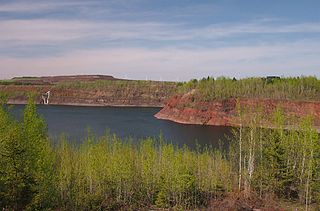
Mountain Iron Mine is a former mine in Mountain Iron, Minnesota, United States. Opened in 1892, it was the first mine on the Mesabi Range, which has proved to be the largest iron ore deposit ever discovered. Mining operations at the site ceased in 1956. The bottom of the open-pit mine has filled with water but its dimensions are readily visible. The city maintains an overlook in Mountain Iron Locomotive Park.

This is a list of the National Register of Historic Places listings in Saint Louis County, Minnesota. It is intended to be a complete list of the properties and districts on the National Register of Historic Places in Saint Louis County, Minnesota, United States. The locations of National Register properties and districts for which the latitude and longitude coordinates are included below, may be seen in an online map.

The Church of St. John the Baptist was a historic church building in Virginia, Minnesota, United States. It was built in 1924 by a Polish American congregation of Roman Catholics. In 1980 the church was listed on the National Register of Historic Places under the name Church of St. John the Baptist (Catholic) for its local significance in the themes of religion and social history. It was nominated for serving as the center of religious and social life for Virginia's Polish Americans.
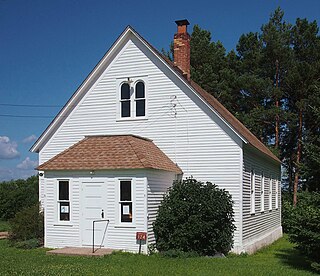
The Cokato Temperance Hall is a historic clubhouse built in 1896 in Cokato Township, Minnesota, United States, to serve as an alcohol-free social center in a rural Finnish American community. It was constructed by a local temperance society at a rural crossroads which became known as Temperance Corner. The building was listed on the National Register of Historic Places under its full Finnish name Cokaton P.R.S. Onnen Toivo Raittiusseura in 1976 for its local significance in the themes of European ethnic heritage and social history. It was nominated for its association with the temperance movement and importance to the cultural life of an immigrant community. The hall is now maintained by the Cokato Finnish American Historical Society, which has moved other historical structures nearby to form the Finnish Pioneer Park.
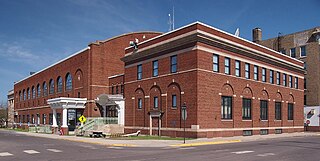
The Virginia Recreation Building is a former community center in Virginia, Minnesota, United States, that was later converted into a factory. It was built in 1923 as an ice hockey and curling rink to provide a public venue for physical development to the working class men largely employed in Iron Range mines. A generation later, as the gender balance of the city's population evened out, the building was converted into a shirt factory in 1947 to create jobs for women. The building was listed on the National Register of Historic Places in 1982 for its state-level significance in the themes of industry and social history. It was nominated for encapsulating the social welfare of the Progressive Era and the robust public spending funded by the mining boom, and the transition to a more gender-balanced population and need to diversify the economy.

The Spina Hotel is a historic former hotel building in Ironton, Minnesota, United States. It was built in 1913 with multiple commercial spaces and grandly designed architecture. The building was listed on the National Register of Historic Places in 1980 for having local significance in the themes of architecture and commerce. It was nominated for illustrating the scale of civic development anticipated but never fully achieved during the boom years of iron mining on the Cuyuna Range.
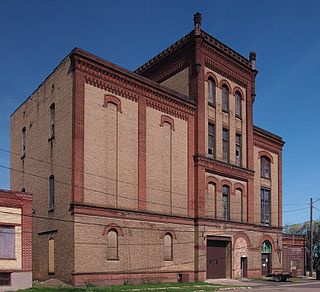
The Virginia Brewery is a former brewery in Virginia, Minnesota, United States. It was built in 1905 and closed during Prohibition. The building was listed on the National Register of Historic Places in 1980 for its local significance in the themes of architecture, commerce, and industry. It was nominated for being a distinctive example of the local breweries that contributed to economic and social life of the Iron Range before Prohibition and competition from larger brands put them out of business.

Kaleva Hall is a historic Finnish-American clubhouse in Virginia, Minnesota, United States. It was operated by the Valon Tuote temperance society from its construction around 1906 until the late 1960s, after which it was acquired by the Knights and Ladies of Kaleva. The building was listed on the National Register of Historic Places in 1980 under its Finnish name Valon Tuote Raittiusseura for its local significance in the themes of education, entertainment/recreation, and social history. It was nominated for continuously serving as the headquarters of one of the city's major ethnic groups throughout the 20th century.
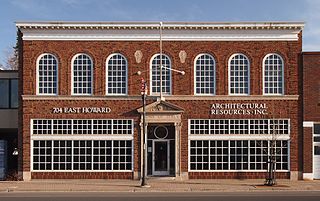
The Sons of Italy Hall is the former clubhouse of an Italian-American fraternal organization in Hibbing, Minnesota, United States. It was built in 1930 and stayed active until 1968. The hall was listed on the National Register of Historic Places in 1980 for its local significance in the theme of social history. It was nominated for reflecting the diversity of the Iron Range immigrant population and the unique way Hibbing's Italian community organized around clubs rather than churches.

The Erick and Kristina Nelimark Sauna is a historic Finnish sauna in Embarrass, Minnesota, United States. It was built around 1930. The sauna was listed on the National Register of Historic Places in 1990 for its state-level significance in the themes of agriculture, architecture, and European ethnic heritage. It was nominated for reflecting the area's settlement by Finnish American farmers and their use of traditional log construction.

The Charles Lenont House is a historic house in Virginia, Minnesota, United States. It was built in 1900 for Virginia's first mayor, Marcus Fay, then sold to Dr. Charles Lenont, who resided there until 1979. In 1980 the house was listed on the National Register of Historic Places for its local significance in the themes of architecture and social history. It was nominated for being the city's best-preserved example of Queen Anne architecture and a manifestation of the class distinctions telegraphed by housing type on the early Iron Range.

The Jukola Boardinghouse is a former boarding house in Virginia, Minnesota, United States. It was built in 1912, one of many constructed as mining began in the Iron Range and thousands of unmarried men arrived to take work. In 1982 the Jukola Boardinghouse was listed on the National Register of Historic Places for its local significance in the themes of architecture, exploration/settlement, and social history. It was nominated as a well-preserved example of this once-common and essential lodging option in the early years of Iron Range mining.

The Hotel Glode is a former hotel building in Eveleth, Minnesota, United States. It also served as a depot on the Mesaba Railway, active 1912–1927 as the first interurban mass transit system on the Iron Range. The Hotel Glode was listed on the National Register of Historic Places in 1980 for its local significance in the themes of commerce and transportation. It was nominated for its role as both an important local hotel and a stop on an early mass transit system.

The Matt and Emma Hill Farmstead is a historic farmstead in Pike Township, Minnesota, United States. It was established in 1897 by one of many Finnish Americans who left employment in Iron Range mines to begin farming northern Minnesota's cutover forests. The farm was listed as a historic district on the National Register of Historic Places in 1990 for its state-level significance in the themes of agriculture, architecture, and European ethnic heritage. It was nominated for reflecting the pivot of St. Louis County's Finnish immigrants from industrial labor to agriculture, and their use of traditional log architecture.

The Coates House is a historic house in Virginia, Minnesota, United States. It was built around 1912 as one of the city's larger and finer residences. A succession of prominent people in the local lumber industry lived in it. The house was listed on the National Register of Historic Places in 1980 for its local significance in the themes of architecture and social history. It was nominated for demonstrating the class distinctions telegraphed by housing stock on the Iron Range at the turn of the 20th century. Large houses for the managerial class provided a sharp contrast to the boarding houses and small cottages into which the period's working class population was crowded.
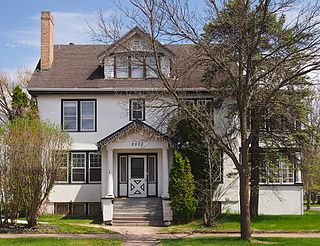
The Emmett Butler House is a historic house in Hibbing, Minnesota, United States. It was built in a simplified Colonial Revival mode in 1916 for Emmett Butler, a local leader and an executive in Minnesota's influential Butler Brothers Construction Company. The house was listed on the National Register of Historic Places in 1980 for its local significance in the themes of architecture and industry. It was nominated as an example of the Colonial Revival houses built in Minnesota in the early 20th century and for its associations with Butler.
























